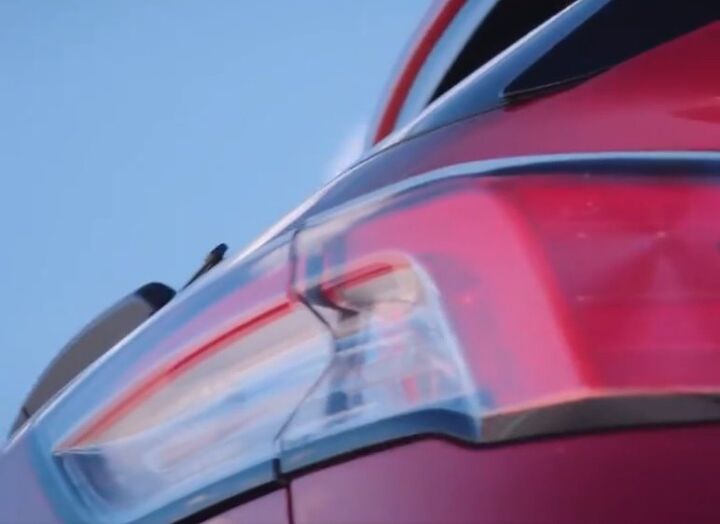Just a Reminder That There's a New Ford Escape Coming

Debuting in North America for the 2013 model year, the third-generation Ford Escape is getting long in the tooth, forced to compete against newer compact crossovers like the Chevrolet Equinox and Honda CR-V. Toyota’s RAV4 is all-new this year, too. And Dodge, well… Dodge still sells the Journey Abe Lincoln drove from rural Illinois to D.C.
Looking to cement its status in this white-hot segment, Ford has a fourth-generation Escape due out later this year. We’ll have full details for you on April 2nd (the media sneak peek was last week), but here’s something to tide you over.
The new Escape’s arrival comes not a moment too soon. Climbing the U.S. sales charts following its 2001 model year debut, the model cracked the 200,000/year mark in 2011 and busted through the 300,000/year mark in 2014. Growth then stalled, with the model’s 2017 high water mark standing at 308,296 units. Amid competition from newer rivals, the aging Escape’s volume fell to 272, 228 units last year.
From the glimpse afforded by Ford’s Twitter account, the Escape dons a tall and wide mesh grille, eschewing the complex visage of years past. It would seem Ford’s aiming for a flat-hooded sense of brawn here. Or maybe a combination of that, plus elegance. “Plasticky” is no longer a good look.
Out back, the rear glass seems more steeply raked than before, topped with a spoiler and underscored by large “ESCAPE” lettering glinting away in chrome. Taillights are an LED-lit, downward hockey stick affair, with the outer edges creeping forward along the rear flanks of the vehicle.
Interior volume and content will surely see upgrades, but don’t expect to see a base S model with Ford’s 2.5-liter four-cylinder in tow. 2020 model-year VIN decoder documents sent from Ford to the National Highway Traffic Safety Administration shows the 1.5-liter Ecoboost inline-four staging a return, with the 2.0-liter unit offered as an upgrade. Unlike the third-gen Escape, there’s also a hybrid option — two, in fact. The VIN docs list both a hybrid and plug-in hybrid powertrain, each utilizing the 2.5-liter and an electric motor. Range, like combined output, is anyone’s guess, but a 2019 Fusion Energi can travel 25 miles before the gasoline mill kicks in.
The hybrid variants can be had in SE, SEL, and Titanium trims, in both front- or all-wheel drive guise.
As we said before, expect a closer look at this vehicle on April 2nd.
[Images: Ford, via Twitter]

More by Steph Willems
Latest Car Reviews
Read moreLatest Product Reviews
Read moreRecent Comments
- Jeff Self driving cars are not ready for prime time.
- Lichtronamo Watch as the non-us based automakers shift more production to Mexico in the future.
- 28-Cars-Later " Electrek recently dug around in Tesla’s online parts catalog and found that the windshield costs a whopping $1,900 to replace.To be fair, that’s around what a Mercedes S-Class or Rivian windshield costs, but the Tesla’s glass is unique because of its shape. It’s also worth noting that most insurance plans have glass replacement options that can make the repair a low- or zero-cost issue. "Now I understand why my insurance is so high despite no claims for years and about 7,500 annual miles between three cars.
- AMcA My theory is that that when the Big 3 gave away the store to the UAW in the last contract, there was a side deal in which the UAW promised to go after the non-organized transplant plants. Even the UAW understands that if the wage differential gets too high it's gonna kill the golden goose.
- MKizzy Why else does range matter? Because in the EV advocate's dream scenario of a post-ICE future, the average multi-car household will find itself with more EVs in their garages and driveways than places to plug them in or the capacity to charge then all at once without significant electrical upgrades. Unless each vehicle has enough range to allow for multiple days without plugging in, fighting over charging access in multi-EV households will be right up there with finances for causes of domestic strife.



































Comments
Join the conversation
Does anybody even care about Ford anymore?
The problem is the Escape falls short of the RAV4 and the Rogue. Remember, Nissan and Toyota also have a full carline to back them up that Ford now doesn't have.